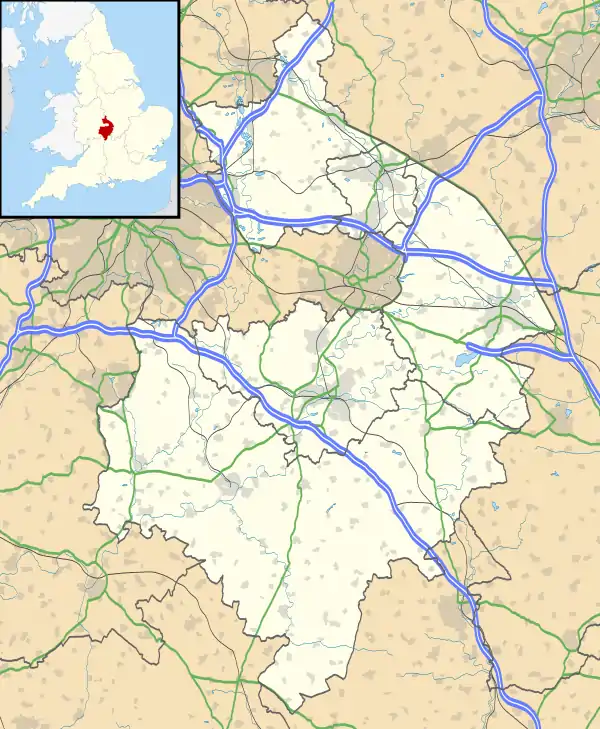Tysoe
Tysoe is a civil parish in the Stratford-on-Avon District of Warwickshire, England. The parish is on the boundary with Oxfordshire, about 7 1⁄2 miles (12 km) northwest of Banbury. The parish includes the contiguous villages of Middle and Upper Tysoe and the separate hamlet of Lower Tysoe. The 2011 Census recorded the parish population as 1,143.[1]
| Tysoe | |
|---|---|
.jpg.webp) St Mary's parish church | |
 Tysoe Location within Warwickshire | |
| Population | 1,143 (2011 Census) |
| OS grid reference | SP3343 |
| Civil parish |
|
| District | |
| Shire county | |
| Region | |
| Country | England |
| Sovereign state | United Kingdom |
| Post town | Warwick |
| Postcode district | CV35 |
| Dialling code | 01295 |
| Police | Warwickshire |
| Fire | Warwickshire |
| Ambulance | West Midlands |
| UK Parliament | |
Toponym
The earliest known surviving record of the place-name is as Tiheshoche in the Domesday Book of 1086. It was Tiesoch in the reign of Henry I (1100–35), Thiesho in a charter from 1131–40 and Tisho in a royal roll from 1201. The name is derived from the Old English Tīges hōh, meaning "spur of land belonging to the god Týr".[2]
Eilert Ekwall speculated: "The etymology suggested is rendered likely by the fact that at Tysoe was a cut figure of a horse, after which the Vale of the Red Horse was named. The horse may have been a monument to a victory won by the Anglo-Saxons dedicated to the war-god."[2]
Ekwall was referring to the Red Horse of Tysoe, a hill figure which was recorded as late as 1607 but which is now lost.[3][4]
Parish church
The earliest parts of the Church of England parish church of The Assumption of the Blesséd Virgin Mary are two blocked windows on the south side of the nave, which date from late in the 11th century.[3]
The south aisle of the nave was added in the middle of the 12th century. In the 13th century the south arcade was extended from three bays to four and the three original arches were altered to give them a pointed Gothic shape. The north aisle was added later and is Decorated Gothic. The nave has a clerestory that was added in the 14th century. In the 15th century the south porch was added, new Perpendicular Gothic windows were inserted and the present west tower was built.[3]
The west tower has a ring of six bells. Richard Sanders of Bromsgrove, Worcestershire cast the treble, second, third and tenor bells in 1719. Abel Rudhall of Gloucester cast the fourth bell in 1750. Matthew III Bagley of Chacombe, Northamptonshire cast the fifth bell in 1782. The church has also a Sanctus bell cast by William Blews and Sons of Birmingham in 1866.[5]
In 1854 the church was restored under the direction of the architect George Gilbert Scott.[3] The church is a Grade I listed building.[6] In the churchyard is a 15th-century preaching cross, which is a Grade II* listed building.[7]
Economic and social history
The oldest part of Tysoe Manor House in Upper Tysoe is the 14th-century hall range. A two-storey wing was added to the house in the 17th century. The house was extended again in 1932–33. It is a Grade II* listed building.[8]
All three Tysoe settlements include 17th-century buildings, especially Middle Tysoe, which was once the main village of the parish.[4]

About 1⁄2 mile (800 m) south of Lower Tysoe is an 18th-century tower mill. The tower is built of local ironstone.[9]
Tysoe has a Church of England primary school.[10] George Gilbert Scott designed the school's original building, which was built in 1856.[11] Extensions to the building were added in the 1980s and 2005.
The agricultural trade unionist Joseph Ashby was born in Tysoe in 1859. His daughter Kathleen Ashby, teacher and historian, was born in Tysoe in 1892 and wrote her father's biography.
References
- UK Census (2011). "Local Area Report – Tysoe Parish (E04009794)". Nomis. Office for National Statistics. Retrieved 7 December 2019.
- Ekwall 1960, Tysoe.
- Pevsner & Wedgwood 1966, p. 435.
- Salzman 1949, pp. 175–182.
- Chester, Mike (11 April 2013). "Tysoe Assumption of BVM". Dove's Guide for Church Bell Ringers. Central Council for Church Bell Ringers. Retrieved 7 December 2019.
- Historic England. "Church of the Assumption of the Blessed Virgin Mary (Grade I) (1186160)". National Heritage List for England. Retrieved 7 December 2019.
- Historic England. "Preaching cross approximately 10 metres south of the nave of the Church of the Assumption of the Blessed Virgin Mary (Grade II*) (1035537)". National Heritage List for England. Retrieved 7 December 2019.
- Historic England. "Tysoe Manor and attached wall (Grade II*) (1186224)". National Heritage List for England. Retrieved 7 December 2019.
- Historic England. "Windmill Hill Windmill (Grade II) (1364775)". National Heritage List for England. Retrieved 7 December 2019.
- Tysoe Church of England Primary School
- Pevsner & Wedgwood 1966, p. 436.
Sources
- Ekwall, Eilert (1960) [1936]. Concise Oxford Dictionary of English Place-Names (4th ed.). Oxford: Oxford University Press. ISBN 0198691033.
- Pevsner, Nikolaus; Wedgwood, Alexandra (1966). Warwickshire. The Buildings of England. Harmondsworth: Penguin Books. pp. 435–436.
- Salzman, LF, ed. (1949). "Tysoe". A History of the County of Warwick. Victoria County History. 5: Kington Hundred. London: Oxford University Press for the Institute of Historical Research. pp. 175–182.
External links
![]() Media related to Tysoe at Wikimedia Commons
Media related to Tysoe at Wikimedia Commons